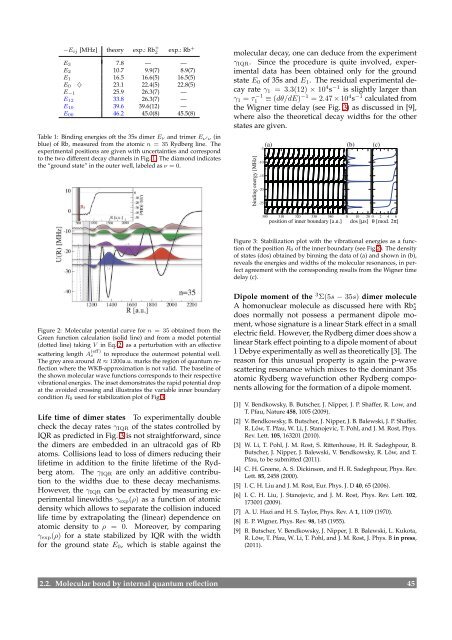Contents - Max-Planck-Institut für Physik komplexer Systeme
Contents - Max-Planck-Institut für Physik komplexer Systeme
Contents - Max-Planck-Institut für Physik komplexer Systeme
You also want an ePaper? Increase the reach of your titles
YUMPU automatically turns print PDFs into web optimized ePapers that Google loves.
−Eij [MHz] theory exp.: Rb +<br />
2 exp.: Rb +<br />
E3 7.8 — —<br />
E2 10.7 9.9(7) 8.9(7)<br />
E1 16.5 16.6(5) 16.5(5)<br />
E0 ♦ 23.1 22.4(5) 22.8(5)<br />
E−1 25.9 26.3(7) —<br />
E12 33.8 26.3(7) —<br />
E10 39.6 39.6(12) —<br />
E00 46.2 45.0(8) 45.5(8)<br />
Table 1: Binding energies oft the 35s dimer Eν and trimer E ν ′ ν (in<br />
blue) of Rb, measured from the atomic n = 35 Rydberg line. The<br />
experimental positions are given with uncertainties and correspond<br />
to the two different decay channels in Fig. 1. The diamond indicates<br />
the “ground state” in the outer well, labeled as ν = 0.<br />
Figure 2: Molecular potential curve for n = 35 obtained from the<br />
Green function calculation (solid line) and from a model potential<br />
(dotted line) taking V in Eq.(2) as a perturbation with an effective<br />
scattering length A (eff)<br />
s to reproduce the outermost potential well.<br />
The grey area around R ≈ 1200a.u. marks the region of quantum reflection<br />
where the WKB-approximation is not valid. The baseline of<br />
the shown molecular wave functions corresponds to their respective<br />
vibrational energies. The inset demonstrates the rapid potential drop<br />
at the avoided crossing and illustrates the variable inner boundary<br />
condition R0 used for stabilization plot of Fig.3.<br />
Life time of dimer states To experimentally double<br />
check the decay rates γIQR of the states controlled by<br />
IQR as predicted in Fig. 3 is not straightforward, since<br />
the dimers are embedded in an ultracold gas of Rb<br />
atoms. Collisions lead to loss of dimers reducing their<br />
lifetime in addition to the finite lifetime of the Rydberg<br />
atom. The γIQR are only an additive contribution<br />
to the widths due to these decay mechanisms.<br />
However, the γIQR can be extracted by measuring experimental<br />
linewidths γexp(ρ) as a function of atomic<br />
density which allows to separate the collision induced<br />
life time by extrapolating the (linear) dependence on<br />
atomic density to ρ = 0. Moreover, by comparing<br />
γexp(ρ) for a state stabilized by IQR with the width<br />
for the ground state E0, which is stable against the<br />
molecular decay, one can deduce from the experiment<br />
γIQR. Since the procedure is quite involved, experimental<br />
data has been obtained only for the ground<br />
state E0 of 35s and E1. The residual experimental decay<br />
rate γ1 = 3.3(12) × 10 4 s −1 is slightly larger than<br />
γ1 = τ −1<br />
1 ≡ (dθ/dE)−1 = 2.47 ×10 4 s −1 calculated from<br />
the Wigner time delay (see Fig. 3) as discussed in [9],<br />
where also the theoretical decay widths for the other<br />
states are given.<br />
binding energy [MHz]<br />
-5<br />
-10<br />
-15<br />
-20<br />
-25<br />
(a) (b) (c)<br />
300 310 320 330 340<br />
position of inner boundary [a.u.]<br />
0 10 20 0 2 4 6<br />
dos [µs] θ [mod. 2π]<br />
Figure 3: Stabilization plot with the vibrational energies as a function<br />
of the position R0 of the inner boundary (see Fig.2). The density<br />
of states (dos) obtained by binning the data of (a) and shown in (b),<br />
reveals the energies and widths of the molecular resonances, in perfect<br />
agreement with the corresponding results from the Wigner time<br />
delay (c).<br />
Dipole moment of the 3 Σ(5s − 35s) dimer molecule<br />
A homonuclear molecule as discussed here with Rb ∗ 2<br />
does normally not possess a permanent dipole moment,<br />
whose signature is a linear Stark effect in a small<br />
electric field. However, the Rydberg dimer does show a<br />
linear Stark effect pointing to a dipole moment of about<br />
1 Debye experimentally as well as theoretically [3]. The<br />
reason for this unusual property is again the p-wave<br />
scattering resonance which mixes to the dominant 35s<br />
atomic Rydberg wavefunction other Rydberg components<br />
allowing for the formation of a dipole moment.<br />
[1] V. Bendkowsky, B. Butscher, J. Nipper, J. P. Shaffer, R. Low, and<br />
T. Pfau, Nature 458, 1005 (2009).<br />
[2] V. Bendkowsky, B. Butscher, J. Nipper, J. B. Balewski, J. P. Shaffer,<br />
R. Löw, T. Pfau, W. Li, J. Stanojevic, T. Pohl, and J. M. Rost, Phys.<br />
Rev. Lett. 105, 163201 (2010).<br />
[3] W. Li, T. Pohl, J. M. Rost, S. Rittenhouse, H. R. Sadeghpour, B.<br />
Butscher, J. Nipper, J. Balewski, V. Bendkowsky, R. Löw, and T.<br />
Pfau, to be submitted (2011).<br />
[4] C. H. Greene, A. S. Dickinson, and H. R. Sadeghpour, Phys. Rev.<br />
Lett. 85, 2458 (2000).<br />
[5] I. C. H. Liu and J. M. Rost, Eur. Phys. J. D 40, 65 (2006).<br />
[6] I. C. H. Liu, J. Stanojevic, and J. M. Rost, Phys. Rev. Lett. 102,<br />
173001 (2009).<br />
[7] A. U. Hazi and H. S. Taylor, Phys. Rev. A 1, 1109 (1970).<br />
[8] E. P. Wigner, Phys. Rev. 98, 145 (1955).<br />
[9] B. Butscher, V. Bendkowsky, J. Nipper, J. B. Balewski, L. Kukota,<br />
R. Löw, T. Pfau, W. Li, T. Pohl, and J. M. Rost, J. Phys. B in press,<br />
(2011).<br />
2.2. Molecular bond by internal quantum reflection 45
















